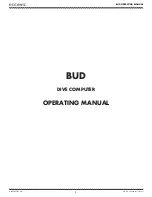
IonPac NS1 Manual
Document No. 034024-06
Page 14 of 35
SECTION 4 - APPLICATIONS
Before attempting any of the following example applications, take the time to ensure that your system is properly configured.
Ensure that all of the eluents have been made from high purity reagents and deionized water. All water used in the preparation
of eluents should be degassed, deionized water. For chemical purity requirements, see Section 3.3, “Chemical Purity Requirements.”
After running synthetic standards to calibrate your system, you may find that real sample matrices foul your columns. For this reason
it is always advisable to use a guard column to protect the analytical column. If column performance deteriorates and it has been
determined that the guard or the analytical column has been fouled, refer to the column cleanup protocols in “Column Care.”
4.1
Ion Pair Chromatography
There are a number of mechanistic hypotheses for ion pair chromatography. In all cases they involve an eluent reagent that
contains a hydrophobic portion and an ionic portion on one molecule. These ion pair reagents can be anionic or cationic. Here
is a partial list of typical ion pair reagents:
A.
Cationic:
Tetramethyl, ethyl, propyl and butyl ammonium salts of the general form:
R
+
R
N
R
R
Counter anions for these quaternary amines are chloride, bromide, phosphate and hydroxide.
B.
Anionic:
Alkyl sulfonates of varying chain length such as pentane, hexane, heptane and octane sulfonates of the general
form:
CH
3
(CH
2
)
n
SO
3
-
Counter cations can be hydrogen ion, sodium ion and potassium ion.
From an ion exchange point of view, it may be said that the hydrophobic part of the ion pair molecule associates with the
hydrophobic surface of the stationary phase. This creates an ion exchange surface that is in dynamic equilibrium with the mobile
phase. The ion exchange capacity can be increased with a higher concentration of ion pair reagent in the eluent.
Inorganic and organic ions can have remarkable selectivity with this technique. The quaternary amine salt reagents make a loosely
defined anion exchange stationary phase. The sulfonates create a similar cation exchange stationary phase. In both cases, the ion
pair reagent itself can act as a mobile phase “pusher” for the analytes.
The following chromatograms and conditions illustrate the versatility of this method.















































